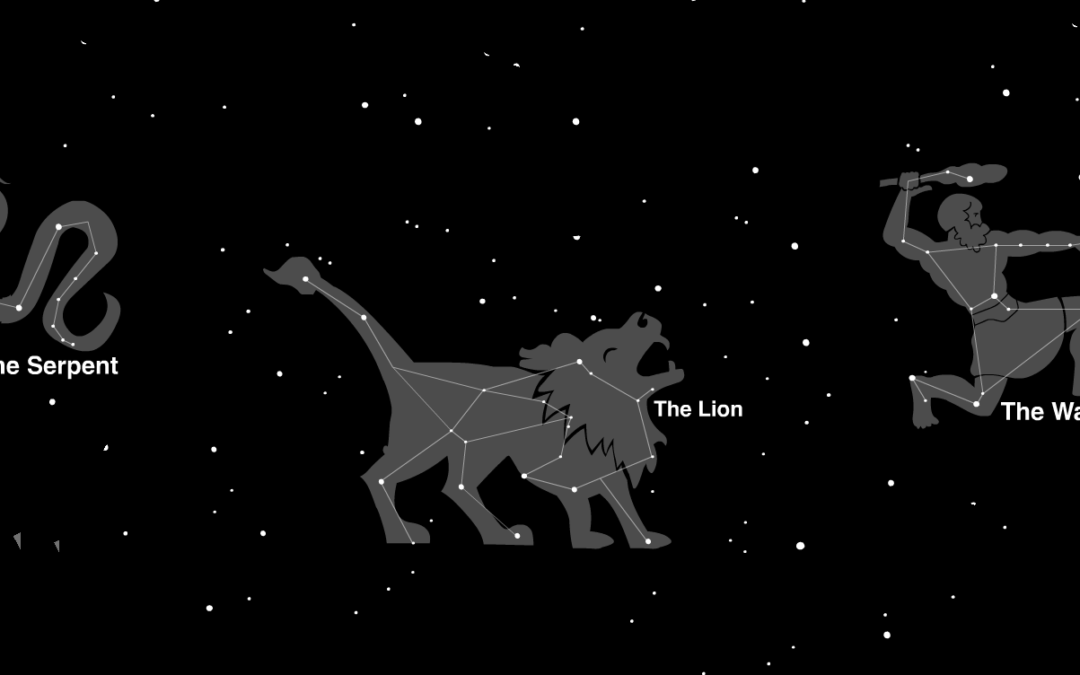Post-covid Leadership
Fiona Passantino, early September 2023
As our world becomes ever more complicated and process-oriented, we find our world becoming very small – our digital spaces, the constant distractions and the noise of our current media landscape. We need big stories of adventure, heroes and villains, guides and demons. Insurmountable obstacles. Undying love, loyalty and determination. This speaks to our core, and we can use the tools of the Epic to deliver information, to inspire, to align and to remind us of who we are. Five tools of the great storytellers.
The Epic
What we see in the night sky are not the stories of Sales Funnels or CRMs but of Orion and the Scorpion or Aquila the ancient falcon of Egypt[15]. These are the same stars that our parents saw, and their parents, and the ancient Greeks and Egyptians, the ancient Chinese traders along the Silk Road.
What we see that connects us, are Epics.
An Epic is a fantastical tale of bravery, loyalty, sacrifice and magic containing valuable lessons and knowledge crucial for our survival. Its purpose is to entertain, teach, inspire and align, a vessel containing collected wisdom and culture[1].
Epics exist in every culture on earth. Peoples from Africa to Asia to Central America that never had contact with one another tell of the same great floods, one-eyed giants and sun chariots[2].

Today’s Stories
Our stories now are about Digital Transformation, Artificial Intelligence and Big Data. These intricate products and processes require near immediate understanding and rapid implementation to run a vastly more complicated, interconnected world.
If only the pure transfer of information and knowledge from one human to another were as simple as a thunderbolt cable and a right mouse click. But facts in a vacuum are meaningless and quickly forgotten.

TOOL 1: The Story
Humans are hard-wired to relate to and engage with a story. Our brains light up in the same was as when we have an actual experience[3]. The story is the silver thread that pulls us through the facts and information, and once it has entered our long-term memories, is the thread we pull to retrieve that knowledge.
When we feel positive towards our learning material, we show improved recall and comprehension[4]. When connected, we are at our most focused and receptive to new information[7]. Engagement also increases our satisfaction, reduces isolation and loneliness, improves our motivation to learn, creating a positive learning cycle[8].
TOOL 2: Epic Archetypes
Every Epic has its Archetypes: these are the common characters we all instinctively know and understand, thanks to years of hearing them over and over again, from Snow White to Star Wars. Most of our ancient and modern Epics alike have a Hero, a Villain, a Guide, a Temptress, a Fool or a Weak King.
Your stories today can pull on these same threads; and these can expand by tapping into archetypes that cut across cultural and geographical borders. By broadening our mythological literacy, we also increase our intercultural understanding, and speak to those who may have grown up with the Mahabharata rather than the Iliad.

TOOL 3: The Metaphor
The metaphor is a powerful tool for getting us there. The term comes from the Greek metapherein which literally means “carrying something somewhere new”. A familiar, mastered idea has the capacity to carry our understanding to a new, place[9].
Metaphors allow us to organize and structure information meaningfully and convey insight through essential combinations[11]. Consider the folder, files and trash can on your desktop, stowaways from our analogue workspaces[10]. The shopping cart helps us grasp e-commerce.
TOOL 4: Repetition
Our brain loves predictability and repetition. It’s just how our brains work. It’s how we learn and solidify information in our memory. Usually in groups of three; three “threepeat” trick this links up with the musical, poetic sensitivity we are born with, and this unlocks our emotional core which is the fast track into our long-term memory centers.
We repeat one part and we vary the rest. Here’s an example:
It was another typical day at the office. Marge from IT was setting out the muffins for her birthday party later in the afternoon.
It was another typical day at the office. Emil was sending out reminders to turn in the slides for the all-hands.
It was another typical day at the office. Supply chain had a breakthrough and solved last week’s materials crisis.
The combination of knowing what’s coming puts us into a patter-recognition mode which hyper-focuses our brains on the variation part of the story. That’s why we remember it. Repetition allows us to pre-organize incoming information that our brains can easily process and understand.

TOOL 5: The Call to Purpose
The Epic, equally, is there to inspire. Why are we doing all these things? What’s the wider vision, purpose, behind picking up the next customer support ticket with an angry person at the other end, or filling in those spreadsheets, again? Are we doing it just for the money?
Chances are, if you’re a Human living in this world, you need much more than a paycheck to get out of bed in the morning. You need purpose. Making purpose the first part of the story instantly connects you with your audience, since they are there for themselves, not for you.

Our Contrasting Needs
We still need the stars, the cave and the fire. The ability to tell our stories, make them understandable and convincing, to inspire and align people of many different backgrounds is the key to our effectiveness as a leader.
Our contrasting need for both fact and myth, the future and the ancient can all co-exist peacefully in the vault of our minds. We are not so advanced and so tech that we cannot long for the Shaman as urgently as we await the release of the latest AI model.

No eyeballs to read or watch? Just listen.
Epic Communication
As our world becomes ever more complicated and process-oriented, we find lives becoming very small – our digital spaces, the constant distractions and the noise of our media landscape. We need big stories of adventure, heroes and villains, guides and demons. Undying love, loyalty and determination. This speaks to our Human core, and we can use the tools of the Epic to deliver information, to inspire, to align and to remind us of who we are. Five tools of the great storytellers.

About Fiona Passantino
Fiona is an AI Integration Specialist, coming at it from the Human approach; via Culture, Engagement and Communications. She is a frequent speaker, workshop facilitator and trainer.
Fiona helps leaders and teams engage, inspire and connect; empowered through our new technologies, to bring our best selves to work. She is a speaker, facilitator, trainer, executive coach, podcaster blogger, YouTuber and the author of the Comic Books for Executives series. Her next book, “AI-Powered”, is coming soon.
SOURCES
[1] Tsai, S. P. (2008). Corporate marketing management and corporate‐identity building. Marketing intelligence & planning.
[2] Foley, J. M. (2004). Epic as genre. The Cambridge Companion to Homer, 171–187.
Aládé, S. &. (2015). A Model for Animation of Yorùbá Folktale Narratives. African Journal of Computing & ICT. 8., 113–120. https://www.researchgate.net/publication/308352527_A_Model_for_Animation_of_Yoruba_Folk
[3] Gillett, R. (2018, May 13). Why We’re More Likely to Remember Content with Images and Video (Infographic). From Fast Company. [Electronic magazine]: https://www.fastcompany.com/3035856/why-were-morelikely-to-remember-content-with-images-and-video-infogr
[4] Mutiarani, M. &. (2019). Indonesian Folklore Animation as English Learning Media and Students’ Character Education for Primary School. Semnasfip.
[5] Kalyanaraman, S. S. (2004). Arousal, memory, and impression-formation effects of animation speed in web advertising. Journal of Advertising 33, 1, 7–17.
Noyes, J. A. (2019). Is a Picture Worth a Thousand Words? Evaluating the Design of Instructional Animations in Veterinary Education. Journal of veterinary medical education, 1–9.
[6] Aládé, S. &. (2015). A Model for Animation of Yorùbá Folktale Narratives. African Journal of Computing & ICT. 8., 113–120. https://www.researchgate.net/publication/308352527_A_Model_for_Animation_of_Yoruba_Folk
Vigoroso, L. C. (2020). Occupational safety and visual communication: User-centred design of safety training material for migrant farmworkers in Italy. Safety science, 121, 562–572.
Martin, F. &. (2018). Engagement matters: Student perceptions on the importance of engagement strategies in the online learning environment. Online Learning, pp. 22(1), 205–222.
[7] Passantino, F. (1999). Making the Net Work for Intercultural Education. European Journal of Intercultural Studies, 10(1), 63–73.
[8] Martin, F. &. (2018). Engagement matters: Student perceptions on the importance of engagement strategies in the online learning environment. Online Learning, pp. 22(1), 205–222.
[9] Eppler, M. J. (2003). The image of insight: The use of visual metaphors in the communication of knowledge. Proceedings of I-KNOW (Vol. 3, September), 2–4.
[10] Colburn, T. R., & Shute, G. M. (2008). Metaphor in computer science. Journal of Applied Logic, 6(4), 526–533. https://reader.elsevier.com/reader/sd/pii/S1570868308000463?token=42683557168FEAD047B2C566767E5BB7D6E7FCF76082D3DA7D3688C8972BD5298702C793E170948B99A29CE5B4715098
[11] Eppler, M. J. (2003). The image of insight: The use of visual metaphors in the communication of knowledge. Proceedings of I-KNOW (Vol. 3, September), 2–4.
[12] RIVM (June 12, 2020). Ontwikkeling COVID-19 in grafieken. Rijksinstituut voor Volksgezondheid en Milieu Ministerie van Volksgezondheid, Welzijn en Sport (RIVM). https://www.rivm.nl/coronavirus-covid-19/grafieken
[13] Whiting, K. (2020, March 4). Coronavirus isn’t an outlier, it’s part of our interconnected viral age. From World Economic Forum: https://www.weforum.org/agenda/2020/03/coronavirus-global-epidemics-health-pandemic-covid-19/
[14] Craven, M. (2020, March 30). COVID-19 Briefing note: our latest perspectives on the coronavirus pandemic. From McKinsey & Company.
[15] Berio, A. (2014). The Celestial River: Identifying the Ancient Egyptian Constellations. SPP, 253, 1–61.Fiona Passantino

